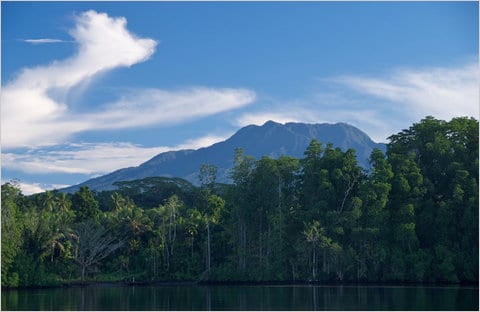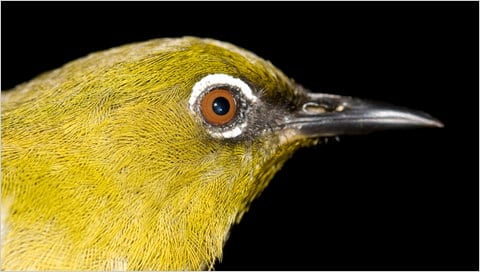
Approaching Kolombangara Island. Photo by Chris Filardi
Sunday, Oct. 10
I awoke in the Solomon Airlines Twin Otter yesterday afternoon and looked groggily out the window. Below sprawled a bewildering array of islands, reefs and tropical ocean blues. On the short one-hour flight between Guadalcanal and my destination in the New Georgia Islands, we traversed the entire geographic ranges of numerous bird species. Laid out almost like a textbook diagram, the geography has helped shape our concept of what a species is.
After landing in Munda on New Georgia Island, we had to lug all 140 pounds of my gear to the wharf, pack and rainproof it in our trusty motor canoe, called Imasa — which in Roviana means “to linger somewhere on the way to someplace else” — and then pick up 200 liters of fuel (about 53 gallons) that had to be pumped from old 200-liter drums and poured into our running and auxiliary tanks in five-liter pitchers.
From where we landed, it was a forty-minute boat trip through the Vonavona Lagoon, part of the largest lagoon systems on earth, to Kolombangara Island. Giant island imperial pigeons, the size of small chickens, commute to fruit trees on the larger “mainland” islands from the dozens of islets we pass where the birds congregate in large communal roosts.
These pigeons are widespread in the southwestern Pacific, showing no variation among populations on different islands in the Solomons.

This is not surprising given their habit of commuting, sometimes long distances, to trees that often fruit asynchronously (like figs) with fruiting individuals separated unpredictably in space and time.
This is a real contrast to the many songbirds that differ among nearly all major islands in the Solomons.
The small fruit- and insect-eating white-eyes are exceptional in this regard. Across the seven major islands of the New Georgia group, some of them only a couple of kilometers apart, there are seven species of white-eyes, including one endemic to an island only about twice the size of Manhattan, and another found only in the cloud forests of Kolombangara and nowhere else on earth. This is one of the birds we will be looking for when we begin our long climb before dawn tomorrow morning.
This is not surprising given their habit of commuting, sometimes long distances, to trees that often fruit asynchronously (like figs) with fruiting individuals separated unpredictably in space and time. This is a real contrast to the many songbirds that differ among nearly all major islands in the Solomons.
The small fruit- and insect-eating white-eyes are exceptional in this regard. Across the seven major islands of the New Georgia group, some of them only a couple of kilometers apart, there are seven species of white-eyes, including one endemic to an island only about twice the size of Manhattan, and another found only in the cloud forests of Kolombangara and nowhere else on earth. This is one of the birds we will be looking for when we begin our long climb before dawn tomorrow morning.

I am now writing from the veranda of the Imbu Rano Lodge. Imbu Rano is a research and education center established through a novel partnership between indigenous landholders and a sustainable plantation timber company that operates in the Kolombangara lowlands. The base and launch point for our expedition to the cloud forests, Imbu Rano is spectacularly perched on the edge of the largest terrestrial biodiversity reserve in the Solomons.
After dinner, colleagues from several local conservation organizations, customary land representatives and other partners all gathered to discuss the expedition.
Conversation quickly turned to two essentials: fire and water. In the highest-elevation forests, dry burnable wood can be nearly impossible to find. No fire, no cooking (a person can live on biscuits alone, but not well). There are trees that will burn green, a sort of “kerosene wood,” though most of our guides agreed we would be too high to find this type of tree. More importantly, despite the sodden conditions of the cloud forests, drinking water can be difficult to find and rainwater hard to collect. Unlike the rain forests of the lowlands, a majority of precipitation in cloud forests comes in the form of mist — and when you are camped at 1,700 meters (5,577 feet) on an 1,800-meter mountain, there is not a lot of room for streams or springs to form.
The remedy in both cases will probably be bamboo. Absent from the lowlands, bamboo thickets pick up around 1200 meters elevation (around 4,000 feet). Standing dry bamboo absorbs little of the misty precipitation and burns well. Green bamboo segments are filled with sweet, grassy-flavored water.

Just out around the lodge trying to catch a satellite signal, I disturb a beautiful little carpet boa locally known as a sleeping snake for its tendency to “sleep” for days in a spot after eating — our first taste of what lies ahead. The forest finally begins to reveal itself after the last engine sounds fade with the trucks that dropped us here, electric light, telephones and the soft chatter of houses and shops far, far below. But it is not quiet as evening comes. Hoots and growls, chirps, trills, clucks, squawks, rasping and grunting sounds — all foreshadow the mystery held by the world we are about to enter.
A previous version of this post misspelled Kolombangara.
